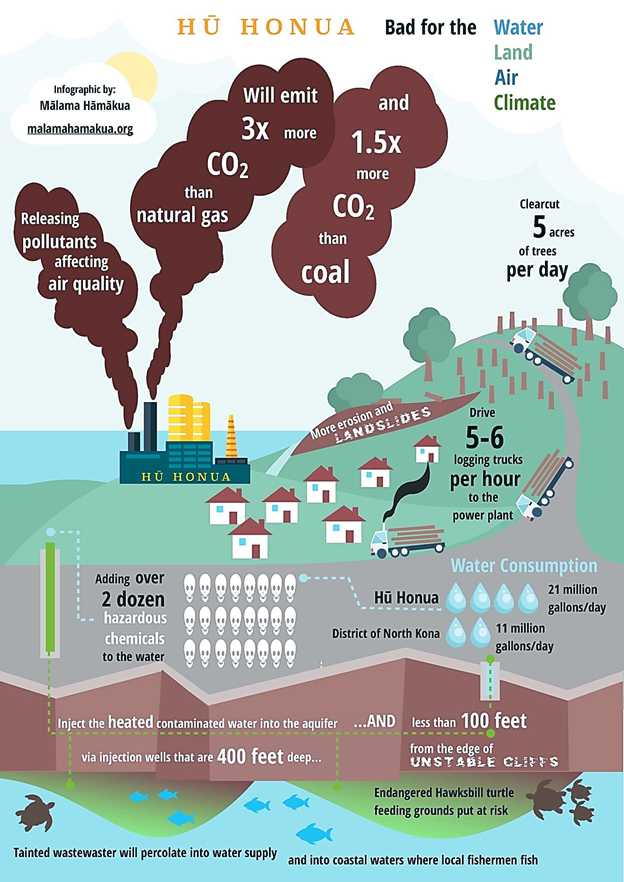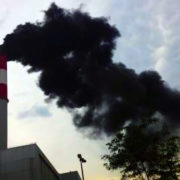Hu Honua 2019 – burning trees for power – Update
The Hu Honua saga continues…
As BeyondKona reported last October in Hawai’i Today (https://www.beyondkona.com/trick-or-treat-a-hu-honua-decision-halloween-2018/), HELCO’s decision to buy power, and thus enable, the controversial (yet to be activated) tree destroying and wood-burning Hu Honua power plant is one example of Hawai’i Island being on the wrong path in its transition to clean energy.
Hu Honua is based on a state-sanctioned renewable energy loophole which allows for wood-burning biomass power plants. Not all biomass projects are created equal, it’s just that Hu Honua is a really bad example of the controversy surrounding biomass energy.
In short, Hu Honua is bad for Hawaii’s environment, bad for ratepayers, and bad for HELCO which has at its disposal far superior and cost effective zero-emissions power options which are available today — options which won’t add to global warming emissions, produce or emit pollution by-products; as is the case with the Hu Honua power plant.
The Hu Honua is a one of kind power plant project for Hawai’i Island. The kind you would expect to find in marginally developed areas of the world with limited power options, not certainly not Hawai’i rich in sun and wind energy, and energy storage options.
The public subsidy of biomass facilities is neither sustainable, green, nor cost-effective.
In the case of the Hu Honua Bioenergy facility, burning trees for power is not only unnecessary, it’s just wrong-headed and poses health and environmental threats to area residents of Hawai’i Island from airborne pollutants and GHG biomass emissions.
The HELCO – HuHonua partnership was a bad deal from the start; for both HELCO ratepayers and Hawaii’s taxpayers while carrying with it an unnecessary high environmental price tag for energy. Hu Honua originally planned to secure a $100,000,000 Federal tax credit, in addition to Hawai’i state subsidies. Although federal Production Tax Credit (PTC) and Investment Tax Credit (ITC) for Biomass Projects expired, the Internal Revenue Service has a Safe Harbor program for biomass projects under construction, which may be applicable to Hu Honua, if they ever become operational.
Fast forward today, the state PUC has been forced, through public interest legal action to re-open its earlier Hu Honua Bioenergy facility approval decision, which did not consider the absence of a required environmental review and full consideration in the PUC – Hu Honua approval decision. In this case, it allowed the applicant (Hu Honua) to shift their environmental impact reporting responsibility to other state agencies that were scheduled to review the project only after the PUC approval.
Process, and the order in which review and decision processes occur can significantly effect the outcome of matters of public interest as is case with Hu Honua’s future. There are many considerations, as the public discovered after the original PUC approval decision, beyond the simple fact that Hu Honua does not burn fossil fuel to produce power on behalf of Hawai’i Island’s ratepayers…
A Picture is Worth a Thousand Words
We could go much deeper in making our case why HuHonua is bad for Hawai’i Island, but the following graphic says it all…





Two additional points. Hu Honua is attempting to circumvent the Clean Water Act by using the UIC program for their thermal discharges. An NPDES permit should be required which, in this case, would trigger a NEPA quality EIS and consultation with federal agencies under the Endangered Species Act as the Hamakua Coast is critical habitat for several species. Their own modeling shows a direct hydrologic connection between the injection wells and the regulated waters of the U.S. The plant is right next to the sea cliff. Even if they drill deeper, they will still be sending pollutants to the ocean.
Solar plus storage is coming in at half the cost per kilowatt hour as the power purchase agreement for Hu Honua. So, twice the cost to consumers.
Every year Helco and DOH cut down hundreds of tons of wood and dump it in the landfill.
Why not burn it instead of oil.
What is currently happening with this horrendous disaster in the making. I can find no recent updates. Is it still aiming towards an opening? Or has a corporate criminal action actually been stopped? – an extremely rare and unlikely event.
Thanks in advance for any update info.
https://www.beyondkona.com/hu-honua-community-update-on-the-controversial-tree-burning-power-plant/